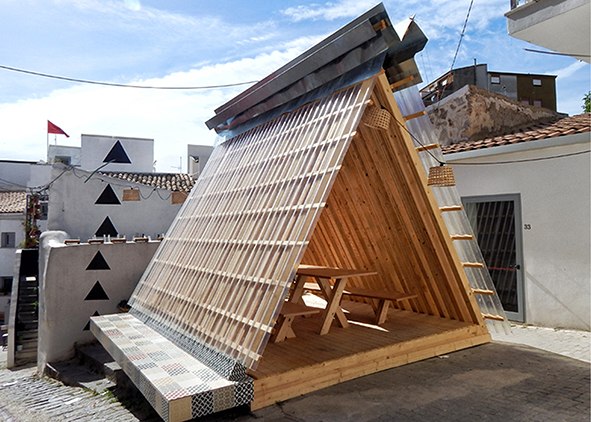Insegnare costruendo. Architettura temporanea tra ricerca e didattica
DOI:
https://doi.org/10.19229/2464-9309/432018Parole chiave:
architettura temporanea, ricerca applicata, didattica sperimentale, shelter, costruzioni sperimentaliAbstract
Lo sviluppo di tecnologie progettuali digitali offre alla didattica indubbi strumenti di proiezione: progettazione, pro jectare, gettarsi in avanti. Design parametrico, BIM, realtà aumentata sono ormai presenti nel lessico e nel bagaglio professionale, ma spesso creano un distacco dalla realtà e dalla materialità. L’architettura, l’unica vera, è quella costruita, in cui l’essenza materica e spaziale dimostra se gli assunti teorici siano o meno validi. Immaginare percorsi didattici che portino gli allievi a realizzare veri manufatti è un approccio innovativo, inusuale, che coniuga ricerca didattica a ricerca materica. L’articolo delinea un percorso di collaborazione fra varie realtà istituzionali e ne traccia premesse, metodologie, risultati, proponendo futuri sviluppi di ricerca e offrendo opportunità di disseminazione, replicabilità e diffusione.
Downloads
##plugins.generic.articleMetricsGraph.articlePageHeading##
Riferimenti bibliografici
Galilei, G. (1623), Il Saggiatore, Acrobat edizioni, Roma. [Online] available at: www.astrofilibresciani.it/Biblioteca_UAB/Biblioteca/Galileo-Saggiatore.pdf [Accessed October 2018].
Kobayashi, H. (2018), “Empathic Design using Agile Technology”, in Proceedings on International Conference on Smart, Sustainable and Sensuous Settlements Transformation (3SSettlements), Munich, Technical University of Munich, Munich. [Online] Available at: www.iaarc-academy.com [Accessed October 2018].
Kuma, K. (2015), Small Architecture / Natural Architecture, Architectural Association Publications, London.
Kuma, K. (2018), “Kengo Kuma: A Lab for Materials”, in JA, n. 109.
Laugier, M. A. (1753), Essai sur l’architecture, Getty Research Institute, Paris. [Online] Available at: archive.org/details/essaisurlarchite00laug/page/10 [Accessed 22 October 2018].
Masera, G., Imperadori, M., Vanossi, A., Liotta, S. J. and Ito, Y. (2015), “Modular, Adaptable Shelters for Environmentally Sensitive Archaeological Sites”, in, Falk, A., Vegh, P. and Chilton, J. (eds.), Proceedings of the IASS Working Groups 12 + 18 – International Colloquium 2015 Bio-based and Bio-inspired Environmentally Compatible Structures, Tokyo Denki University, Tokyo. [Online] Available at: hdl.handle.net/11311/962428 [Accessed October 2018].
Vanossi, A., Parello, G., Imperadori, M., Bennardo, C., Liotta, S. J. and Ito, Y. (2014), “BIM for archaeology, Use of BIM process and parametric model in a temporary shelter adaptable to the diverse needs of archaeological sites”, in Della Torre, S. and Borgarino, M. P. (eds), Proceedings of the International Conference Preventive and Planned Conservation 2014, Nardini Editore, Monza, Mantova.
Vanossi, A., Parello, G., Imperadori, M., Bennardo, C., Liotta, S. J., Ito, Y. and Occhipinti, F. (2015), “Architecture for Archeology: identifying new modular and flexible types of shelter adaptable to the diverse needs of archaeological sites”, in Gambardella, C. (ed.), Best practices in heritage conservation and management from the world to Pompeii, Atti del XII Forum Internazionale Le Vie dei Mercanti, La Scuola di Pitagora, Anversa-Capri. [Online] Available at: www.leviedeimercanti.it/wp-content/uploads/2015/11/Pagine-da-sintesi-Atti-XII-Forum.pdf [Accessed October 2018].
www.artesella.it [Accessed October 2018].
www.farmculturalpark.com [Accessed October 2018].
www.smartgeometry.org/sg2008-munich/ [Accessed October 2018].

##submission.downloads##
Pubblicato
Come citare
Fascicolo
Sezione
Licenza
AGATHÓN è pubblicata sotto la licenza Creative Commons Attribution License 4.0 (CC-BY).
License scheme | Legal code
Questa licenza consente a chiunque di:
Condividere: riprodurre, distribuire, comunicare al pubblico, esporre in pubblico, rappresentare, eseguire e recitare questo materiale con qualsiasi mezzo e formato.
Modificare: remixare, trasformare il materiale e basarti su di esso per le tue opere per qualsiasi fine, anche commerciale.
Alle seguenti condizioni
Attribuzione: si deve riconoscere una menzione di paternità adeguata, fornire un link alla licenza e indicare se sono state effettuate delle modifiche; si può fare ciò in qualsiasi maniera ragionevole possibile, ma non con modalità tali da suggerire che il licenziante avalli l'utilizzatore o l'utilizzo del suo materiale.
Divieto di restrizioni aggiuntive: non si possono applicare termini legali o misure tecnologiche che impongano ad altri soggetti dei vincoli giuridici su quanto la licenza consente di fare.
Note
Non si è tenuti a rispettare i termini della licenza per quelle componenti del materiale che siano in pubblico dominio o nei casi in cui il nuovo utilizzo sia consentito da una eccezione o limitazione prevista dalla legge.
Non sono fornite garanzie. La licenza può non conferire tutte le autorizzazioni necessarie per l'utilizzo che ci si prefigge. Ad esempio, diritti di terzi come i diritti all'immagine, alla riservatezza e i diritti morali potrebbero restringere gli usi del materiale.


















































































